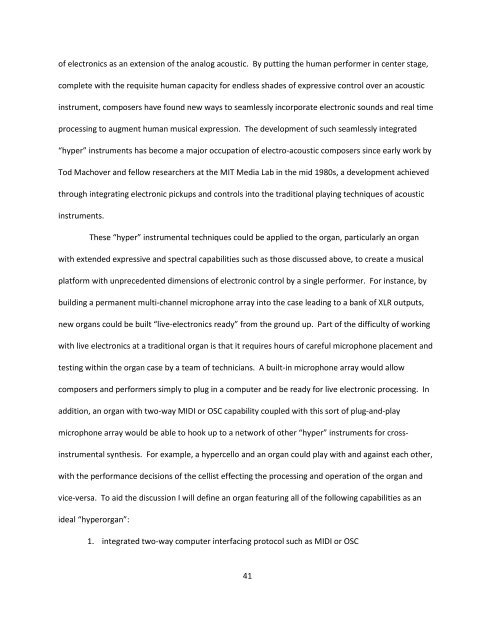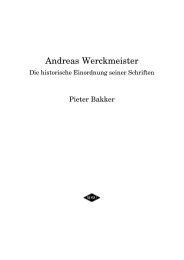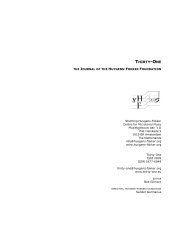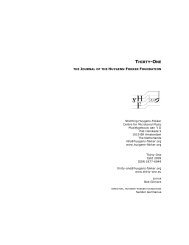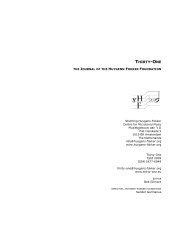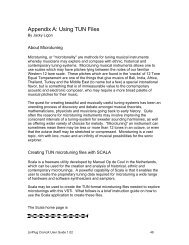Recent Organ Design Innovations and the 21st-century - Stichting ...
Recent Organ Design Innovations and the 21st-century - Stichting ...
Recent Organ Design Innovations and the 21st-century - Stichting ...
Create successful ePaper yourself
Turn your PDF publications into a flip-book with our unique Google optimized e-Paper software.
of electronics as an extension of <strong>the</strong> analog acoustic. By putting <strong>the</strong> human performer in center stage,<br />
complete with <strong>the</strong> requisite human capacity for endless shades of expressive control over an acoustic<br />
instrument, composers have found new ways to seamlessly incorporate electronic sounds <strong>and</strong> real time<br />
processing to augment human musical expression. The development of such seamlessly integrated<br />
“hyper” instruments has become a major occupation of electro-acoustic composers since early work by<br />
Tod Machover <strong>and</strong> fellow researchers at <strong>the</strong> MIT Media Lab in <strong>the</strong> mid 1980s, a development achieved<br />
through integrating electronic pickups <strong>and</strong> controls into <strong>the</strong> traditional playing techniques of acoustic<br />
instruments.<br />
These “hyper” instrumental techniques could be applied to <strong>the</strong> organ, particularly an organ<br />
with extended expressive <strong>and</strong> spectral capabilities such as those discussed above, to create a musical<br />
platform with unprecedented dimensions of electronic control by a single performer. For instance, by<br />
building a permanent multi-channel microphone array into <strong>the</strong> case leading to a bank of XLR outputs,<br />
new organs could be built “live-electronics ready” from <strong>the</strong> ground up. Part of <strong>the</strong> difficulty of working<br />
with live electronics at a traditional organ is that it requires hours of careful microphone placement <strong>and</strong><br />
testing within <strong>the</strong> organ case by a team of technicians. A built-in microphone array would allow<br />
composers <strong>and</strong> performers simply to plug in a computer <strong>and</strong> be ready for live electronic processing. In<br />
addition, an organ with two-way MIDI or OSC capability coupled with this sort of plug-<strong>and</strong>-play<br />
microphone array would be able to hook up to a network of o<strong>the</strong>r “hyper” instruments for cross-<br />
instrumental syn<strong>the</strong>sis. For example, a hypercello <strong>and</strong> an organ could play with <strong>and</strong> against each o<strong>the</strong>r,<br />
with <strong>the</strong> performance decisions of <strong>the</strong> cellist effecting <strong>the</strong> processing <strong>and</strong> operation of <strong>the</strong> organ <strong>and</strong><br />
vice-versa. To aid <strong>the</strong> discussion I will define an organ featuring all of <strong>the</strong> following capabilities as an<br />
ideal “hyperorgan”:<br />
1. integrated two-way computer interfacing protocol such as MIDI or OSC<br />
41


